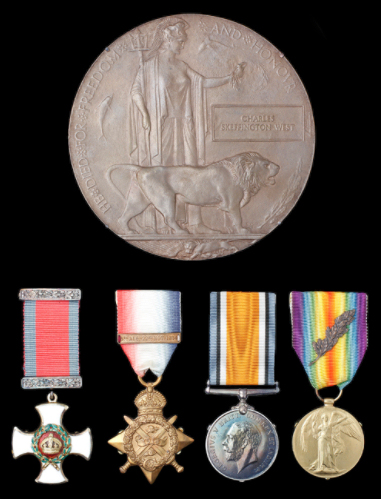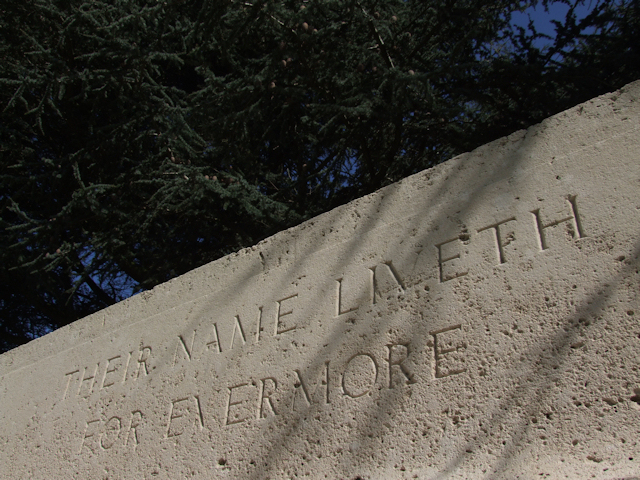Name
Charles Skeffington West (DSO)
Conflict
First World War
Date of Death / Age
30/12/1917
30
Rank, Service Number & Service Details
Commander
Royal Naval Volunteer Reserve
Howe Bn. Royal Naval Division.
Awards: Service Medals/Honour Awards
Not Yet Researched
Distinguished Service Order, Mentioned in Despatches three times
Cemetery/Memorial: Name/Reference/Country
METZ-EN-COUTURE COMMUNAL CEMETERY BRITISH EXTENSION
II. F. 6.
France
Headstone Inscription
Not Researched
UK & Other Memorials
Sacombe Village Memorial
Pre War
Son of the Rev. H. M. West and Mrs. Helen M. West, of Staverton, Wokingham, Berks. born at Temple Michael Rectory, Longford, Ireland in 1886, the son of the Reverend H.M. West and 1st cousin of Lieutenant-Colonel Richard Annesley West, V.C., D.S.O., M.C.; educated at St. Clare, Walmer, Trinity College, Cambridge University and HMS Britannia, Dartmouth Naval College.
His family lived at Chetwode House in Wokingham. The house itself no longer exists but there is a little lodge house on the main road by St Crispin’s School called Chetwode and a close of detached houses just behind there called Chetwode Close.
He was commissioned to midshipman, Royal Navy, 15.5.1902 and served in the Channel Squadron, 1902-1903; the China Squadron, 1903-1905; Acting Sub-Lieutenant 15.7.1905; was invalided from 1905 on his return from China until 1908; entered Trinity College, Cambridge, 1911, taking a 2nd Class in the History Tripos.
Wartime Service
At the outbreak of the Great War he volunteered and was gazetted temporary Lieutenant, Royal Naval Volunteer Reserve, 24 August 1914.
He was promoted Lieutenant-Commander and went with Hawke Battalion Royal Naval Division as part of the 1st R.N. Brigade to Dunkirk 5 October 1914; from here he was engaged in the Defence of Antwerp, and fighting a withdrawal he was one of approximately 1,500 men who crossed the Dutch Frontier to escape Antwerp. He was interned in Holland but ‘escaped’ with two others in disguise.
Having managed to return to the England, he was posted to Gallipoli as Second-in-Command of the Collingwood Battalion and landed on the Peninsula 28/29th May 1915. The Collingwood joined the Howe, Hood and Anson Battalions in the 2nd R.N. Brigade. Charles’ battalion arrived in time to participate in the Third Allied attack on Krithia, which was to be a direct frontal assault on the whole of the Turkish forward position, On the 4th June the British attack was to be carried out by the 29th, 42nd and Naval Divisions, each attacking the Turkish trenches opposite their own.
At 12 noon the [R.N.D.] assaulting force consisted of roughly 1,900 men and 70 officers. By the time they returned to the British lines at 12.45, there were only 5 officers and 950 men. Charles who had commanded the men of Collingwood held in Brigade reserve was wounded during the action.
The losses had been so severe that the men were absorbed into the Hood, Howe and Anson Battalions; after three weeks of recuperation in Alexandria Charles returned to Gallipoli as Second-in-Command of the Howe Battalion, a position which he was to hold until the R.N.D.´s evacuation from Gallipoli, January 1916.
In May 1916 he went with the Howe Battalion to The Western Front West in France, moving on to the Somme Front at the beginning of October in anticipation of being involved in a renewed offensive; final orders, for what was to be the Battle of Ancre, were received on the 10th November - the plan was for an attack on Serre, Beaumont Hamel, Beaucourt and St. Pierre Divion by the 2nd Division of the XIIIth Corps, the 3rd, 51st and Naval Divisions of the Vth Corps and the 31st Division of the IInd Corps.
The Naval Division´s sector (1,200 yards in width) was immediately north of the Ancre, at right angles to the river valley, which ran here almost due east to Beaucourt, while he main British and German trenches ran roughly north and south. The Division´s objective was Beaucourt and the intervening positions opposite to their front.
They advanced behind the creeping barrage and successfully pressed home their objectives (including the German front line system). The R.N.D. secured Beaucourt the following day, during this action, which was to be the final act of the Battle of the Somme in 1916. It was during this action that Lieutenant-Colonel B. Freyberg (Officer Commanding Hood Battalion) won his Victoria Cross. The Howe Battalion suffered heavy losses marching out from the battle with less than 100 men.
After the Battle of Ancre the Naval Division was withdrawn from the battle area for two months´ rest.
Charles returned to the same front in January 1917, still as part of the 188th Brigade. By this time the British lines had been pushed forward some distance beyond Beaucourt, but were still below the crest of the ridge which commanded Grandcourt; with the capture of the latter West´s battalion moved into Grandcourt, 6 February 1917 and were in action again, spearheading the Naval Division´s part of the attack on Miraumont, 17-18 February 1917. The attack was ‘brilliantly successful’, and in the case of the Howe Battalion (on the right) the casualties were extremely light.
On the morning of February 18th, a counter-attack developed, but it was annihilated before it reached British lines by a barrage from the divisional artillery and the 188th and 190th Machine-Gun Companies. On the night of the 21st-22nd, the 188th Brigade handed over the new position ‘consolidated and intact’ - the 1st Royal Marines, who had partnered Charles’ Battalion in the attack, had suffered over 400 casualties, whereas Howe had suffered 2 officers and 20 men killed.
At the end of February the Naval Division was relieved from duty in the line, with Charles’ men in action again during the Spring Offensive of 1917; at the end of March the Naval Division reached the front north of Arras and then were engaged during the first Battle of Gavrelle, April 1917; involved in almost continuous fighting between 15th April-29th April, the Naval Division suffered total battle casualties of 170 officers and 3,624 other ranks, of whom upwards of 40 officers and 1,000 other ranks were killed. Commanding Officer at last, much re-organisation was required after the battle, including ´Commander Ramsay Fairfax, C.M.G., D.S.O., R.N., Commanding the Howe Battalion, who was invalided during May and was succeeded by Commander C.S. West, D.S.O., R.N.V.R., who had gone out to Gallipoli as second in command of the unfortunate Collingwood Battalion´.
London Gazette 17.4.1917 T/Lt.-Com. Charles Skeffington West, R.N.V.R. ´For conspicuous gallantry and devotion to duty. He rendered invaluable service by most ably guiding and placing companies of the battalion in their battle positions within 400 yards of the enemy. He worked continuously under heavy hostile shell-fire, and was largely responsible for the success of the operations.´
Waiting for the delayed Flanders Offensive to begin the Naval Division were tasked to carry out a number of minor operations to keep the enemy occupied and concerned about other attacks.
On the night of 14th-15th July a new front line was dug in Oppy Wood by the Hawke and Hood Battalions and in front of the Windmill and on July 20th a very successful raid was carried out on Gavrelle Trench by the Howe Battalion. The raid had been carefully planned and rehearsed under the supervision of Commander C.S. West, and commanded by Lieutenant W. Marlow, R.N.V.R. the reported losses were 7 men killed and 1 officer and 25 men wounded). The enemy losses were reported as greater and the number of prisoners alone exceeded the British casualties.
At the end of September the Naval Division was drafted in to participate in the much delayed Flanders Offensive, the objective of which at the time was the Passchendaele ridge. Charles’ battalion as part of the 188th Brigade carried out an attack towards Poelcappelle, as part of the 2nd Battle of Passchendaele, (26 October 1917); in terrible mud and with awful communications the 188th Brigade carried at least five strongly fortified enemy posts and an advance of 300 to 400 yards from the old front; Sir Hubert Gough said, ´no troops could have had to face worse conditions´; 5 officers of the Howe Battalion were killed and ´the losses in N.C.O.´s and men were equally severe, averaging more than 500 a battalion in the 188th Brigade´. The Naval Division were relieved from the front line on the 6 November 1917. On the 6th December the Division entrained for the Cambrai front; on arrival they moved into positions on Welsh Ridge, and were tasked with fortifying them, 15th-20th December. They were still holding the positions on 30 December 1917 when the Germans launched a counter attack against the whole front. Where the Howe’s were, the situation was serious. The front line was lost and a shell falling outside Battalion HQ killed, Commander West and Lieutenant-Commander Alan Campbell.
Commander West is buried in the Metz-en-Couture Communal Cemetery, British Extension.
The War Office issued the following notice in 17th April 1917: “T/Lt.-Com. Charles Skeffington West, R.N.V.R. For conspicuous gallantry and devotion to duty. He rendered invaluable service by most ably guiding and placing companies of the battalion in their battle positions within 400 yards of the enemy. He worked continuously under heavy hostile shell-fire, and was largely responsible for the success of the operations.”
Acknowledgments
Malcolm Lennox



